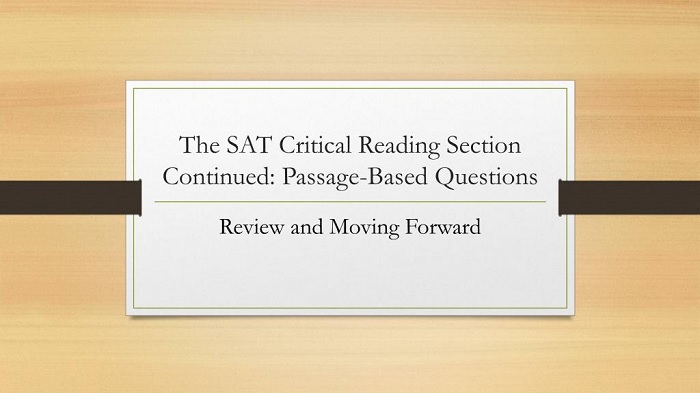Table of Contents
- How to Analyze SAT Critical Reading Passages Quickly
- A Step-by-Step Guide to Answering SAT Critical Reading Questions
- The Top 10 Tips for Mastering SAT Critical Reading
- 6 Common Mistakes to Avoid When Taking the SAT Critical Reading Section
Taking the SAT can be challenging, especially when it comes to the Critical Reading section. This section consists of questions related to passages that you must read and then answer. To do well in the SAT Critical Reading section, you need to understand the structure of the exam and the types of questions that are asked. Additionally, you must become comfortable with the format of the passages and the types of questions that follow them. In this guide, we’ll provide you with tips and strategies that will help you achieve success in the SAT Critical Reading section.
5 Strategies to Improve Your Critical Reading Score on the SAT
1. Read and answer each question: Before you begin to answer the questions on the SAT, you should read the passages thoroughly. Be sure to understand the information provided and to make note of any key words that stand out.
2. Break down passages into smaller parts: Breaking down each passage into smaller parts can help to better understand the content. Use headings and subheadings to divide the passage into more manageable segments.
3. Take notes: Taking notes as you read can help you to remember important details and to recall the passage more efficiently.
4. Practice critical reading: Improve your critical reading skills by practicing with practice tests and sample questions. This will help you build a familiarity with the types of questions you will encounter on the SAT.
5. Utilize resources: Utilize resources to help you answer questions and to improve your overall score. Consider working with a tutor or using online materials to supplement your studies.
How to Analyze SAT Critical Reading Passages Quickly
1. Read through the passage quickly to get an overall idea of the main theme and the main points.
2. Look for keywords and key phrases that might help you quickly understand the main ideas of the passage.
3. Identify any questions that appear in the passage and take note of them.
4. Analyze the structure of the passage. Look for the main idea and supporting details.
5. Read the questions associated with the passage.
6. Skim through the passage and look for words or phrases that might answer the questions.
7. Make sure that your answers are based on evidence from the passage.
8. Read your answers carefully before submitting them.
A Step-by-Step Guide to Answering SAT Critical Reading Questions
Introduction The SAT Critical Reading section is designed to assess your ability to understand and analyze long passages. To do well on this portion of the test, you must be able to read critically and draw logical conclusions from the text. In this guide, we will discuss the strategies you need to know to answer the questions in this section accurately and quickly.
1. Read the Passage Before you can answer any questions, you must read the passage. As you read, it’s important to pay attention to the main points and any key details. This will help you better understand the text and answer the questions accurately.
2. Identify the Question Type Once you have read the passage, you should take a moment to identify the type of question you are being asked. There are three main types of questions in the SAT Critical Reading section:
3. Main Idea: These questions ask you to identify the main point or purpose of the passage.
4. Details: These questions ask you to identify specific details or facts from the passage.
5. Inference: These questions ask you to draw a conclusion or make an educated guess based on the information in the passage.
6. Read the Question Carefully Once you have identified the type of question, you should read the question carefully. This will help you to understand exactly what the question is asking, and it will help you to avoid any confusion when you look for the answer in the passage.
7. Find the Answer in the Passage Once you have read the question carefully, you should look for the answer in the passage. This can be done by quickly scanning for key words or phrases in the passage that relate to the question.
8. Check Your Answer Once you have identified the answer in the passage, you should take a moment to double-check that it is correct. Make sure that the answer you have chosen is supported by evidence in the passage. Conclusion The SAT Critical Reading section is a challenging part of the test, but it can be conquered with practice and the right strategies. By following the steps outlined in this guide, you should be able to answer all of the questions in this section accurately and quickly. Good luck!

The Top 10 Tips for Mastering SAT Critical Reading
1. Become familiar with the test format: Knowing the structure of the SAT Critical Reading test can help you better prepare for it. Familiarize yourself with the number of questions in each section, the types of questions asked, and the allotted time for each section.
2. Understand the types of questions: Be aware of the different types of questions that make up the SAT Critical Reading exam. These include sentence completion, reading comprehension, and passage-based questions.
3. Practice: The best way to become comfortable with the SAT Critical Reading exam is to practice. Take practice tests and go over the answers to familiarize yourself with the topics and types of questions that may be asked.
4. Read actively: When reading passages, be sure to take notes, answer questions as you read, and track the main ideas and key points. This will help you better understand the passage and answer the questions with confidence.
5. Use process of elimination: Eliminating wrong answers can help you narrow down your choices and increase the chances of selecting the correct answer.
6. Know the types of traps: Become familiar with common traps that can be found in SAT Critical Reading questions, such as double negatives, qualifiers, and absolutes.
7. Pace yourself: The SAT Critical Reading exam is timed, so make sure you are able to manage your time effectively. Take a few moments to read through the entire section and plan out your approach before you begin answering questions.
8. Skip difficult questions: If you’re having difficulty with a particular question, skip it and come back to it if you have time. This will help you avoid wasting precious time on a single question.
9. Be confident: Don’t let the SAT Critical Reading exam overwhelm you. Confidence is key, so trust your instincts and don’t second guess yourself.
10. Take care of yourself: Make sure you get plenty of rest the night before the test and fuel your body with a nutritious breakfast the day of the exam. Being well-rested and nourished will help you do your best.
6 Common Mistakes to Avoid When Taking the SAT Critical Reading Section
1. Not Reading the Questions Carefully: Be sure to read the entire question before attempting to answer it. Make sure you understand what is being asked and then look for the answer in the passage.
2. Moving Too Quickly: The SAT Critical Reading section is timed, so it is important to read quickly and accurately. However, you should also take enough time to read the questions carefully and make sure that you understand the answers.
3. Not Understanding the Passage Structure: Pay attention to the structure of the passage.
4. Not Understanding Vocabulary: If you come across a word you don’t know, try to determine its meaning from context clues. If that doesn’t work, use the process of elimination to narrow down the possible answers.
5. Not Using Process of Elimination: Always eliminate any answer choices that you know are incorrect. This will make it easier to identify the correct answer.
6. Not Taking Breaks: It is important to take breaks while taking the Critical Reading section. This will give your brain a chance to rest and to help you stay focused.
Conclusion
In conclusion, the SAT critical reading section is a test of your overall reading comprehension and analytical skills. To do well in this section, it is important to practice reading challenging texts and doing practice questions. Additionally, it is important to become familiar with the structure of the exam, as well as the types of questions you are likely to encounter. By understanding the material, building your reading speed and accuracy, and using strategies to answer the questions, you can do well in the SAT critical reading section.
